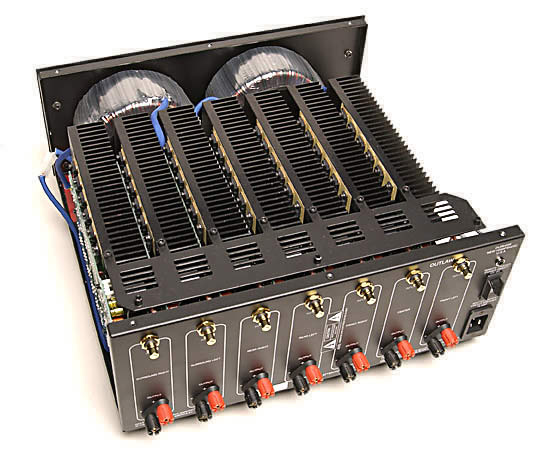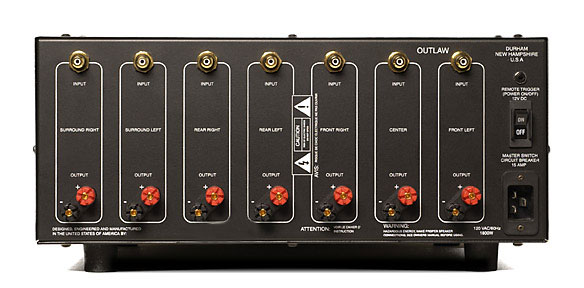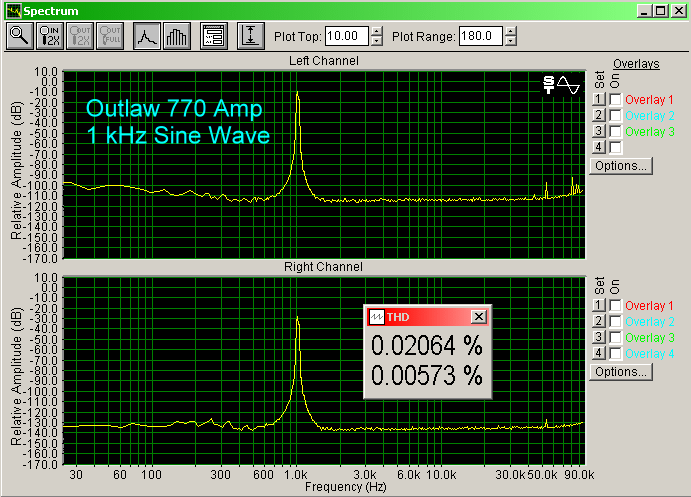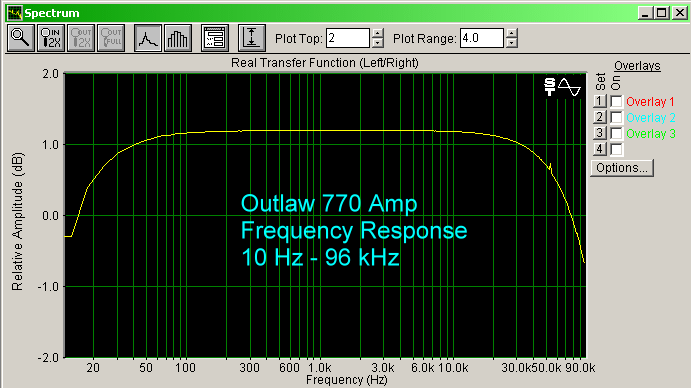|
|

|
|
Specifications:
●
Power output: 200 watts RMS x 7 (all
channels driven simultaneously into 8 ohms from 20 Hz to 20 kHz with less
than 0.05% total harmonic distortion). 300 watts
RMS x 7 @ 4 ohms
●
S/N: 119 dB
●
Power Bandwidth:5 Hz - over 100 kHz (+0/-3
dB)
●
Damping factor: 850 (10 Hz - 400 Hz)
●
Input sensitivity/Impedance: 1.43 volts
for full output/28 k ohms
●
Crosstalk: Greater than -90 dB from 20 Hz
to 20 KHz
●
Gain: Voltage gain of 28 dB
●
Slew rate: 50 Volts/microsecond
●
Remote Trigger voltage: 3 - 32 volts DC
●
Power requirements: 115 V 50-60 Hz
●
Power consumption: 1,800 watts (maximum)
●
Dimensions 7 3/4" H x 17 1/4" W x 18" D
●
Weight: 90 Pounds
●
MSRP $1,799 USA
Outlaw
Audio
http://www.outlawaudio.com
|
|
Introduction
I have been a reluctant convert to home theater. My preference has been
to put any extra money into my two channel system. The driving force in a
movie is plot, not sound quality, at least that is what my opinion used to
be.
Nonetheless, my unnatural attraction to these
rectangular boxes that aid in the production of sounds eventually led me to
assemble a sound system to accompany my RPTV. I have discovered that
assembling and tweaking any sound system, no matter the number of
amplification channels, is my idea of a good time. As I said, it's an
unnatural attraction.
Asked to review the Outlaw 770 seven channel amp, my first thought was that I
don't have seven channels worth of speakers. Then I realized that I do. They
were not all manufactured by the same company or even in the same decade, but
since (as I have noticed) not a whole lot is going on in the rear speakers
most of the time I said, "Sure."
Along the way I discovered that there is no
such thing as too many amplifier channels. Well, there may be, but even with
the seven channel 770, I still don't have quite enough. More on that later.
There have to be some tradeoffs with a seven channel amp. For instance,
portability. According to the Outlaw website, the 770 weighs in at 90 pounds.
My first guess would have been over 100, but then I'm getting older. Normally
I would recommend that you have the dealer near where you buy a piece like this
deliver and set it up, but since Outlaw is an Internet-only operation, you'll
get the delivery but not the setup. So, have someone on hand to help unpack
and move this behemoth. A hand truck is a good idea (requirement) for
negotiating stairs. It also might be a good idea to shield the ears of any
young children in the room the first time you lift this thing, as certain
expletives seem to naturally accompany such a maneuver.

The mass of the 770 is due to two large toroidal transformers and seven
vertically oriented heat sinks (photo above). The transformers are mounted vertically at
the front of the unit, and the amplifier channels are arranged neatly in
rows, front to back. The top and bottom are extensively louvered to allow
ample airflow. The Outlaw Audio website points out that no fans are
required, but some amount of air space around the amp is necessary. The rubber feet for the
770 are the tallest I have seen for an audio component. They are not
attached when you take the amp out of the box. They attach easily with the
screws provided and elevate the 770 a full inch off of whatever surface you
place it on. I presume that this height is to allow for airflow underneath
the box. Do not defeat it by placing the amp on a carpet.

Of course, all of this attention to cooling means that the 770 will throw a
bit of heat into your room. I welcomed this heat on the average cool Oregon
day, but I was reluctant to fire this baby up during the brief hot spells
that we get here. Once warmed up, the 770 was on the high end of what I would
call warm to the touch, but I never found it to be hot.
This warming up proved to be crucial to the sound of the 770. I had to throw
out review notes more than once when I realized (remembered) that after
about 15 minutes of operation, the sound of the 770 completely changes. When
cold, the amp sounds slightly muddied, with not as much distinction between
instruments and voices as I like. Once the amp is warmed, up the sound
blooms. For non-critical listening, I have my doubts that anyone would notice
this. I did not make any effort to let the amp warm up first when I was just
plopping down to watch a movie, and the sound was fine. Warming up was only a
factor when I had my reviewer's pen out and focused my attention.
For movies, the 770 proved to be completely involving, with voices sounding
natural and distinct. Incidental sounds also were reproduced with clarity
and pleasing textures that drew me in. For demanding movie music, I relied on
musical numbers from "Hedwig and the Angry Inch". Let's just say I rocked
out. For those other demanding movie sounds (gunfire and explosions), I use
‘The Matrix' as my reference recording. The ‘Lobby Shooting Spree' scene (as
well as the many other shooting sprees) were reproduced with clarity and
aplomb.
Overall, I was pleased with the sound, finding ample power and no particular
colorations except perhaps a slight reticence in the high mids. For movies,
this was hardly noticeable and perhaps welcome as a way to take the edge off
some overly bright movie soundtracks. My home theater uses JMLab Cobalt
816's for the front speakers and an 806 for the center channel. These speakers can
be a little bright as well, so I enjoyed the match with the Outlaw.
Now, what to do with seven channels? It turns out that my preamp-processor
will not drive a center rear without an upgrade, but I had a better idea. The Cobalts are bi-wirable/bi-ampable. To bi-wire would not require any
additional amplifier channels, only additional speaker wire. Bi-wiring would
only yield a modest change in most systems, I suspect. Bi-amping on the other
hand utilizes two amplifiers per speaker, with one amplifier driving the
woofer of the speaker, and the other driving the mid and tweeter. (The Cobalts are ‘two and half-way' speakers, meaning that one six inch driver
operates as a woofer, while an identical driver operates as a midrange. A
single tweeter handles the highs.) Two sets of speaker connection
posts are provided on the back. For normal operation, the connections are jumpered together. To bi-amp, the jumper is removed, and a separate amplifier
is wired to each set of posts.
This not only dedicates more power to each speaker, it presents each
amplifier channel with a simpler load. The complex three way crossover is
replaced with the easier to drive two way. The eternal speaker conundrum is
that two way speakers sound better for 90% of the musical spectrum but are
missing the lowest bass frequencies. Adding the bass requires a third driver
but complicates the crossover in such a way that something is lost.
Potential solutions are a subwoofer, heroic, massive amplifier design or bi-amping.
Bi-amping is great if you've got lots of amplifiers lying around. Enter the
770.
With the JMLabs bi-amped by the 770, music became completely involving. Low's
(the musicians, not the frequency range!) new album "Trust" features a typically
haunting opening track recorded with loving attention. On this track the
vocal part consists of one male voice and one female voice. Only in this bi-amped
configuration could I hear the two voices separately. The bass guitar and
drums were also more clearly separated. I was engrossed. Beck's newest
record, "‘Sea Change", is a low key affair with many sounds, electronic and
otherwise in the high mid range that I was having trouble hearing before.
With the bi-amp configuration, it sounded nearly as good as through
headphones. I was not enjoying this record very much until I heard it this
way. Switching back to movies, the presentation was more relaxed and
natural. Even in the shoot-em-up scenes, each of the many sounds were
distinct with no glare or edginess.
After a thorough workout in my home theater, I moved the 770 upstairs for a
go in my two channel system. As heavy as the amp is, it was easier to move
one heavy item upstairs than two large, heavy speakers downstairs. My music
system speakers are Gold Sound 9's, which are three-ways, utilizing 15”
woofers. After the requisite warm-up period, two channels of the 770 had no
trouble driving the big speakers to loud levels of enjoyable sound. I still
heard the slight reticence in the upper mids. This was particularly
noticeable on piano music. Still, any good recording was completely
enjoyable, and I found myself listening longer than I had intended. I found
that deep bass tones sounded more natural with the Outlaw than with my
reference (Edge M-4). This may have been a function of slightly less control,
as the Edge amps are famous for commanding bass control, but the Outlaw never
sounded loose or flabby.
Problems/Complaints
In the bi-wire configuration, I heard a high pitched tone through the
speakers as the amp powered off. I was able to minimize this by leaving the
preamp on while the Outlaw used up its capacitive reserves after the power
switch was thrown. Because of this issue, I neglected to troubleshoot the 12V
trigger jack. The cable provided with the amplifier was a ‘stereo' cable
(three total conductors), while the online manual suggests that a two
conductor (mono) cable is appropriate. There was also a slight 60 cycle hum
when the amplifier was on but not driven. It was not audible enough to
bother me. The online manual has many good suggestions for fixing hums. Only
one other glitch, the speaker connectors seem to be made of thin plastic. If
Outlaw needs to save money on these connectors in order to improve the
quality of internal parts, then so be it. The connectors are a small issue,
and I forgot about them soon after I had the amp wired up.
On The Bench (JEJ)
Single sine wave tests at 1
kHz, as well as IM tests, using 11 kHz and 12 kHz sine waves, resulted in
very low distortion, as shown below. As a matter of fact, harmonics are not
even visible on the graph with the 1 kHz input, and are just barely visible
with the IM test.


The measured frequency response
begins to roll off below 100 Hz and above 7 kHz, but is within 1 dB from 20
Hz to 70 kHz.

Conclusions
At $1,799 for 7 x 200 watts of amplification, the Outlaw 770 is clearly one of
the best deals out there whether you measure by watts, channels, or pounds.
Even if you are reluctant to surround yourself with more and more speakers,
seven channels of amplification gives you the option should the movie world
decide to go that way. Or if your speakers allow for it, bi-amping is a
terrific use of the extra amps. I am so happy with bi-amping and the 770, I
plan to buy the review sample. I actually wish I had even one more channel
of amplification as my center channel speaker is bi-ampable as well.
Note: The power cord provided is extra heavy to accommodate the load of
seven channels. The cord is not quite seven feet long, and the termination at
the amplifier end is slightly larger, and with a different orientation of the
blades than I have seen on other equipment. This is an electrical code
requirement for 20 amp components, so you will need to install an
appropriate AC wall socket if you don't already have them. Even the heavy cords seen on most audiophile
amplifiers are not quite as thick as this one. The outside diameter is a full
3/8”. If you need more length, Outlaw recommends an extra large diameter
extension cord. Make sure that whatever cord you use does not get warm after
running the amp for a while.
- Rick Schmidt -
Terms and Conditions of Use

|









